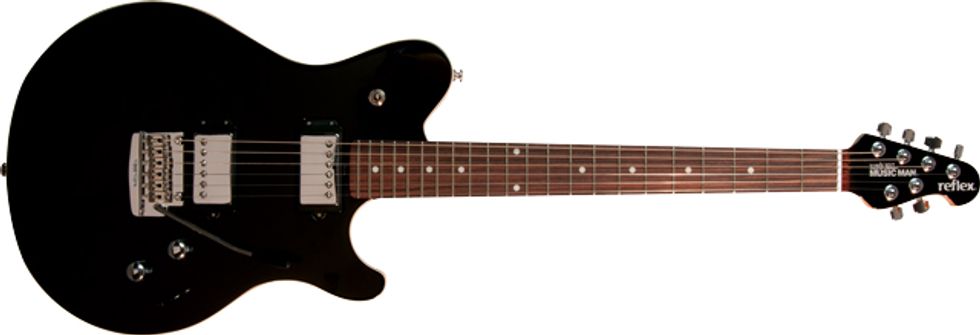Whether or not you want to admit it, a lot of the most important recent advancements in guitar electronics have been based on digital technology. Sure, the market for repro PAF pickups and half-century-old tube circuits isn’t going to die anytime soon, but the modeling market has exploded with very innovative ways of replicating those tones and creating new ones.
Yet there’s still something about the magic of a good magnetic pickup that enthralls players. And with the Game Changer, Ernie Ball embraces digital technology not as a means of generating tones, but for better harnessing the possibilities of electromagnetic pickups. The end result gives players the ability to change the routing and phasing of the coils in every conceivable way to create an enormous palate of sounds.
That’s the Name of the Game
The Game Changer’s 25th-anniversary-style
single-cut body is made from chambered
basswood with a mahogany tone block and
capped with a maple top. You’ll have to be
content with gloss black, as it’s the only finish
option. But I don’t think most will be
as disappointed as they might think after
seeing how utterly gorgeous the finish looks
with this body style—especially with the
elegant single-ply cream binding.
There’s little to tip you to the capabilities of the Game Changer. The string-through, chrome-plated steel vibrato system, two DiMarzio custom-designed humbuckers with chrome covers, single volume and tone controls, and a pair of 2- and 5-way switches for selecting the internal circuitry’s pickup combinations don’t suggest anything too out of the ordinary.
A 22-fret maple neck is attached to the body via Music Man’s well-regarded 5-bolt neck joint, and comes with either rosewood or maple fretboard options. The neck is also rubbed with a combination of gunstock oil and wax, lending a natural, broken-in feel akin to a much-loved baseball bat. Up on the headstock, a set of Schaller locking machines keep the tuning stable and add a nice counterweight that keeps the instrument balanced when standing and playing.
Sounds pretty cut-and-dry so far, right? Well, the Game Changer doesn’t boast about game changing for nothing. Concealed in the body there’s a complex pickup coil routing system, which is powered by three AA batteries and routed to an analog output for pure, unadulterated tone from the pickups. The difference is that players can use either a dedicated web browser plug-in via USB, or an iOS app for their iPads through MIDI, to program any of the literally thousands of possible pickup combinations available in the guitar— which range from traditional to odd. Ever wondered what your guitar would sound like with the coil closest to the neck wired in series with the coil closest to the bridge, and one of the two out of phase? Perhaps not, but you can experiment with that sound in a flash by setting up the Game Changer pickup array through the computer interface.
Each configuration you create—or borrow and download from a fellow Game Changer player—is loaded into the guitar in banks A and B, and a third bank controlled by the switch on the upper bout. You access banks A and B by pushing down or pulling up on the tone control. Bank A and B each store five separate configurations that you can summon via the 5-way switch. The third bank—Bank Z—stores 15 more configurations that you scroll through using the 2-way switch on the upper bout.
Programming patches into the Game Changer is a breeze. After plugging in the included USB cable and loading the free plug-in from Ernie Ball’s website into Firefox, the guitar’s patch bays were displayed in a matter of seconds, and I could change the routing for the stock patches and create new ones from scratch. Understanding the graphical interface isn’t completely intuitive, but it’s not hard either, and after watching a short supplied video clip explaining the process, I had it mastered in a couple of minutes. And since the 1/4" output remained active while the guitar was connected to my computer, I could immediately hear the fruits of my explorations.
Game On!
The Game Changer is a very playable instrument.
And you get great tones from the
most basic voices of the two DiMarzios. But
you don’t have to dig too deep to see how
versatile and potent this tone machine is.
The Game Changer eschews a control-heavy configuration for a more elegant and classic look, which has a significant impact on the guitar’s effectiveness in performance situations. Dialing up the first patch in Bank A (a traditional bridge humbucker mode), the Game Changer delivered a robust clean tone with a nice sweet spank in the highs. The DiMarzio-built custom bridge humbucker has good balance across the board, but pushes the high-midrange frequencies and articulates the pick attack very well for a throatier sound, and overall it’s a solid foundation for exploring the less conventional tones.
For simplicity’s sake, I checked out some simple combinations wired in series for Bank A and in parallel for Bank B. And it was pretty clear in these setups that the pickup routing circuitry does little to diminish the natural tone of the humbuckers. They sounded great in each configuration and showed off the Game Changer’s excellent ability to cover genres ranging from jazz and country to the heaviest of metal mayhem.
Beyond the simple series/parallel setup, the variation in tone only got more impressive. But the more varied the pickup setups, the more difficult it became to keep track of just which patch I had selected. The Game Changer has no way of indicating what configuration it’s in, so you’ll have to rely on your memory, as well as touch and feel to figure out where you are in a performance. And while you can create a printout from the computer or iPad interface, it was hard not to wish for some more immediate reference.
Ratings
Pros:
Extremely versatile pickup routing. great fundamental
humbucker sounds. Flawless fit, finish, and build. excellent
tuning stability.
Cons:
Easy to lose track of which routing is assigned to
which patch.
Tones:
Playability/Ease of Use:
Build:
Value:
Street:
$2,275
Ernie Ball/Music Man
musicman.com
Some of the more unorthodox patches yielded the most interesting tones, especially those that use an out-of-phase coil thrown in for extra texture. Two setups in particular—a combination of the coils closest to the neck and bridge with the inner bridge coil set out of phase, and another with the bridge in full-on humbucking mode with the outer neck coil wired in parallel— added zeal to pick attack and tightening up low-end output. Even in these unconventional configurations, the guitar’s output remained relatively level. And the more-or-less uniform output means you can move between radically different settings and achieve tonal variations you’d otherwise turn to your pedalboard for. It takes practice and familiarization, but the end result can be truly impressive.
The Verdict
Ernie Ball’s Game Changer is a worthy
addition to the popular Music Man line.
The tonal applications are unquestionably
useful if you’re the kind of player who
relishes the capabilities that reside within
an instrument rather than stompboxes.
And the switching possibilities the Game
Changer enables are groundbreaking.
The guitar’s simplicity is endearing and will go a long way in helping win over less gadget-oriented purists. But there’s no getting around that it can also be a hindrance when you lose track of which patch you programmed into the selected slot. Yes, your computer or iPad can give you all that information in a flash, and the interface is pretty streamlined, but a lot of players are reluctant to introduce such an outwardly digital element to their rig. Nevertheless, the Game Changer is a perfect example of how older technology can be enhanced by cleverly applied digital power without sacrificing analog charm. And if you want nothing more than optimal control over the rich analog tones you love dearly, the Game Changer will be a breath of fresh air.












![Rig Rundown: Russian Circles’ Mike Sullivan [2025]](https://www.premierguitar.com/media-library/youtube.jpg?id=62303631&width=1245&height=700&quality=70&coordinates=0%2C0%2C0%2C0)










